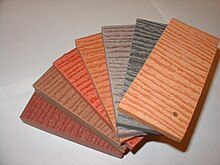
Engineered wood, also called mass timber, composite wood, man-made wood, or manufactured board, includes a range of derivative wood products which are manufactured by binding or fixing the strands, particles, fibres, or veneers or boards of wood, together with adhesives, or other methods of fixation[1] to form composite material. The panels vary in size but can range upwards of 64 by 8 feet (19.5 by 2.4 m) and in the case of cross-laminated timber (CLT) can be of any thickness from a few inches to 16 inches (410 mm) or more.[2] These products are engineered to precise design specifications, which are tested to meet national or international standards and provide uniformity and predictability in their structural performance. Engineered wood products are used in a variety of applications, from home construction to commercial buildings to industrial products.[3] The products can be used for joists and beams that replace steel in many building projects.[4] The term mass timber describes a group of building materials that can replace concrete assemblies.[5]
Typically, engineered wood products are made from the same hardwoods and softwoods used to manufacture lumber. Sawmill scraps and other wood waste can be used for engineered wood composed of wood particles or fibers, but whole logs are usually used for veneers, such as plywood, medium-density fibreboard (MDF), or particle board. Some engineered wood products, like oriented strand board (OSB), can use trees from the poplar family, a common but non-structural species.

Alternatively, it is also possible to manufacture similar engineered bamboo from bamboo; and similar engineered cellulosic products from other lignin-containing materials such as rye straw, wheat straw, rice straw, hemp stalks, kenaf stalks, or sugar cane residue, in which case they contain no actual wood but rather vegetable fibers.
Flat-pack furniture is typically made out of man-made wood due to its low manufacturing costs and its low weight.
- ^ "Brettsperrholz". dataholz.com. Archived from the original on September 6, 2017.
- ^ Green, Michael (2011). The Case for Tall Wood Buildings. Michael Green Architecture. ISBN 978-1-366-37741-8.
- ^ A Guide To Engineered Wood Products, Form C800. Apawood.org. Retrieved on February 10, 2012.
- ^ Naturally:wood Engineered wood Archived May 22, 2016, at the Portuguese Web Archive. Naturallywood.com. Retrieved on February 15, 2012.
- ^ "Mass Timber in North America" (PDF). American Wood Council. November 8, 2018. Archived from the original (PDF) on July 21, 2021. Retrieved February 7, 2020.